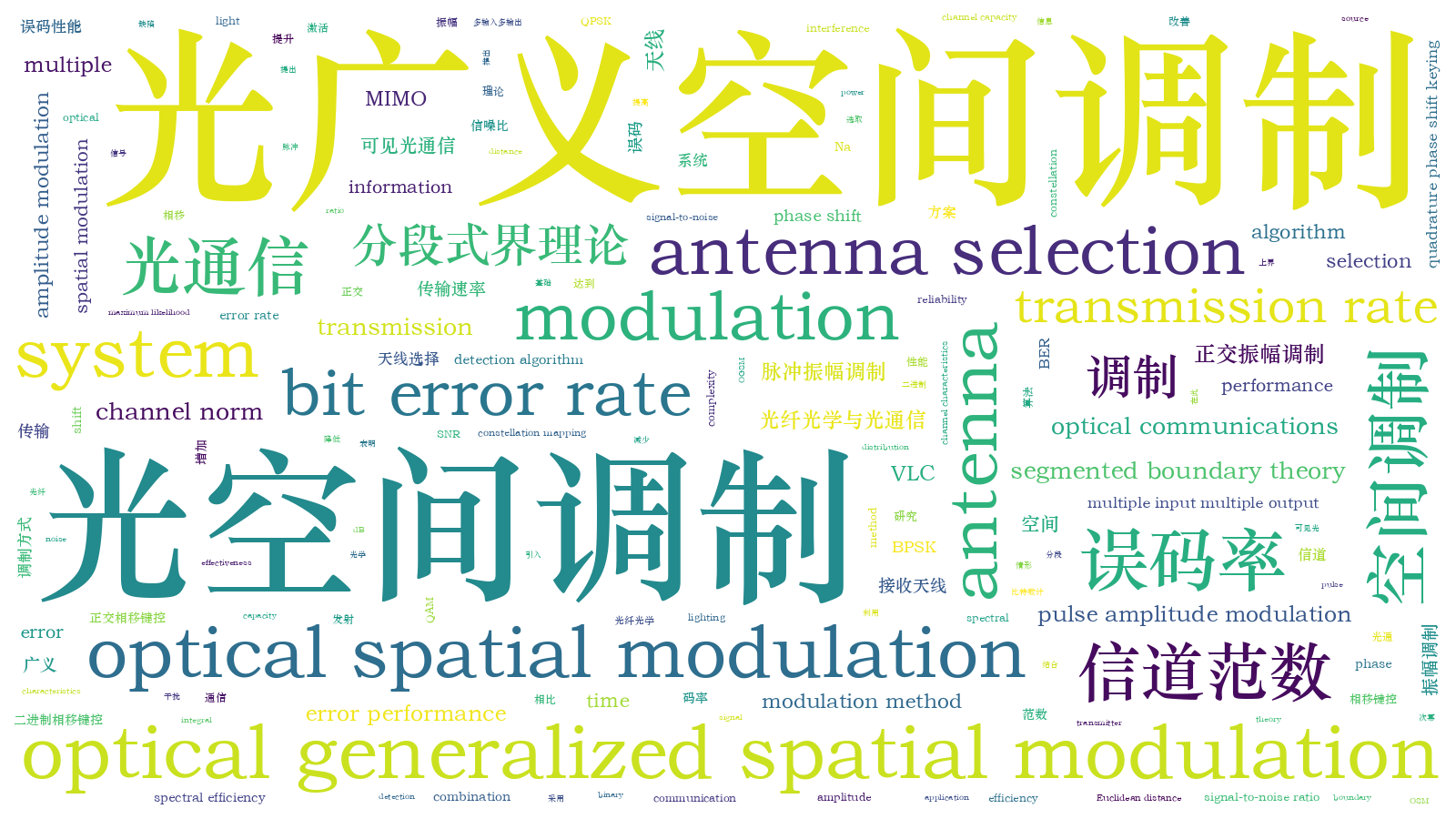基于光广义空间调制的VLC-MIMO系统研究  下载: 614次
下载: 614次
Visible light communication (VLC) needs to take into account both lighting and communication, so multi-light-source distribution is required, and optical multiple input multiple output (OMIMO) technology emerges. The traditional OMIMO system improves the channel capacity by activating all antennas to transmit information, resulting in strong co-channel interference between channels and poor information reliability. Optical spatial modulation (OSM), as a new type of OMIMO technology, activates one transmit antenna at every moment to avoid co-channel interference between channels. At the same time, since the transmitting antenna itself carries some bit information, the transmission rate of the system is improved. However, OSM must meet the requirement that the number of transmit antennas is an integral power of 2, and only one antenna is used at the same time, which limits its application. On the basis of the OSM system, the optical generalized spatial modulation (OGSM) system transmits information by activating multiple antennas. At the same time, all activated antennas can transmit the same or different data information, thereby further improving the transmission rate. But the antenna selection of OGSM is random, so we propose a VLC multiple input multiple output (MIMO) system scheme based on OGSM. The scheme improves the transmission rate by activating multiple transmitting antennas and combining with modulation methods such as multiple phase shift keying (MPSK) system; at the same time, a norm-based antenna selection algorithm is introduced, which greatly reduces the computation complexity.
In order to analyze the performance of OGSM system, we combine OGSM system with OMIMO system. At the transmitter, the number of activated transmit antennas is used to carry the constellation modulated transmission symbols to construct a constellation mapping table; at the same time, in order to improve the bit error performance, a norm-based antenna selection algorithm is introduced in combination with the channel characteristics. The system selects the sub-channel with the largest channel norm to transmit information in turn, and then selects the optimal antenna combination. At the receiving end, in order to obtain the antenna combination and modulation symbols, the maximum likelihood (ML) detection algorithm is used to obtain the Euclidean distance. The theoretical bit error rate (BER) of the OGSM system is analyzed through the segmented boundary theory. Furthermore, the spectral efficiency, transmission rate and complexity of the OGSM system under different conditions are analyzed (Table 2).
For reliability, we use a norm-based antenna selection algorithm to improve the bit error performance. When the number of active antennas Na at the transmitting end is 2, the modulation method is binary phase shift keying (BPSK), and the transmission rate is 4 bpcu, it can be obtained that for the BER of 10-4, using the norm-based antenna selection algorithm, and for 2, 3, and 4 receiving antennas, the average signal-to-noise ratio (SNR) is improved by 3.1 dB (Fig. 2). When the modulation method is BPSK, the number of active antennas Na at the transmitting end is 2, and the number of receiving antennas Nr is 1 and 2 respectively, for the BER of 10-4, the SNR of 4 receiving antennas scheme is reduced by 8.4 dB in comparison with the 3 receiving antennas scheme (Fig. 3). When the number of active antennas Na at the transmitting end is 2, the number of receiving antennas Nr is 2, and the modulation methods are BPSK, 4-pulse amplitude modulation (4PAM), quadrate amplitude modulation (QAM), and quadrature phase shift keying (QPSK), for the BER of 10-3, compared with BPSK, the transmission rates of the other three modulation methods are all increased by 2 bpcu, and the SNRs are increased by 0.7 dB, 3.2 dB, and 5.1 dB, respectively (Fig. 4). For effectiveness, with the increase of the modulation order and the number of activated transmit antennas, the transmission rate and spectral efficiency will increase (Table 2).
Aiming at the disadvantage that OSM can only activate one antenna at the same time, an OGSM scheme is proposed. This scheme significantly improves the transmission rate of the system by changing the transmitting antenna number from one to multiple and by using modulation methods such as MPSK. At the same time, using the norm-based antenna selection algorithm, the system gets better bit error performance than those using the traditional random antenna selection algorithm. The main conclusions include: by increasing the number of receiving antennas, the bit error performance will be improved; when the number of activated transmitting antennas is constant, by using different modulation methods, such as BPSK, QPSK, 4PAM, and QAM, with the increase of the modulation order, the transmission rate of the system will increase, but the bit error performance will be impaired.
1 引言
光多输入多输出(OMIMO)[1-4]系统通过激活所有天线传输信息来提高信道容量,导致信道间同频干扰强,信息可靠性差。光空间调制(OSM)[5-7]作为新型OMIMO技术,通过每时刻激活一根发射天线,可避免信道间同频干扰的影响,但其存在激活天线数是2的整数次幂的缺点,并且同一时刻仅利用一根天线,因而有一定的局限性。
光广义空间调制(OGSM)[8-9]系统是在OSM系统的基础上,通过激活多根天线传输信息,同时所有激活天线可以发射相同或者不同的数据信息,进一步提升了系统的传输性能,受到广泛关注。
在OGSM系统中,通过改进检测算法可以提高系统误码性能,但性能提升并不明显。天线选择算法通过选择相关度低的天线组合优化误码性能,从而受到人们关注。文献[10]将空时分组-空间调制(STBC-SM)级联编码引入到OMIMO中,改善了误码性能。文献[11]利用脉冲幅度调制构建了OGSM,有效地改善了OGSM的误码性能。文献[12]进一步推导出了OGSM系统中最大似然(ML)检测准则下误码率(BER)的性能界。文献[13]提出了基于欧式距离的优化天线选择算法,通过遍历所有天线之间的欧氏距离,选取相关度较低的天线,改善了误码性能,但该算法复杂度高,在实际应用中具有很大的局限性。文献[14]提出基于交叉熵的天线选择算法,从有限解中选择出最优天线,不需要遍历,有效降低了基于欧式距离优化天线选择算法的搜索复杂度,但该算法只适合于空间调制(SM)系统。文献[15]提出了基于相关的快速天线选择算法,通过选择功率较大且相关性越小的行作为接收天线,降低了复杂度,但误码性能较差。
上述工作各有特色,但均有误码性能差或复杂度高的缺陷。因此,在可见光通信(VLC)情形下,本文提出基于OGSM的VLC多输入多输出(MIMO)系统方案。该方案通过激活多根发射天线,并结合多相制(MPSK)等调制方式来提高传输速率;同时,引入基于范数的天线选择算法[16],通过选取信道范数最大的子信道来传输信息,不需要遍历所有的天线组合,极大地降低了复杂度。所提出的系统提升了传输速率,改善了误码性能。
2 基本原理
假设一个具有Nt根发射天线和Nr根接收天线的OGSM系统,如
OGSM系统通过发射天线的符号状态可分为两种:第一种是同一时刻激活的天线组合发送独立的调制信号,这种方式可以明显提高系统的传输速率;第二种是同一时刻激活的天线组合发送相同的调制符号,这种方式可有效避免同步干扰。
第一种方式的OGSM在同一时刻传输的比特数为
第二种方式的OGSM在同一时刻传输的比特数为
如
2.7 OGSM调制原理
在OGSM系统中,传输比特由两部分组成,一部分是调制信号,另一部分是天线组合映射的比特信号。如
经星座映射后的调制符号将会由激活的Na根发射天线发送出去,激活符号具体表现为
经过调制后的符号矢量通过Nr×Nt维的无线信道
将
在接收端,激活发射天线的序号组合与调制符号可以通过最大似然检测算法得到,经解映射得到原始比特信息。最大似然算法的思想是通过激活的天线组合乘以信道矩阵
2.8 天线选择
传统MIMO系统的天线选择算法有穷举天线算法、最大化最小欧氏距离算法、随机选择算法、基于范数的天线选择算法等[17]。其中前二者需要遍历出每一个天线子集,计算复杂度高;随机选择算法的思想是不考虑信道状态,随机选择天线组合,计算复杂度低,但性能差。本文通过基于范数的天线选择算法来选择天线组合,以提高系统性能。
假设信道状态信息(CSI)已知,且系统的传输速率为4 bpcu(bpcu指每信道中传输的比特数),其中发射天线数Nt=4,接收天线数Nr=4,调制阶数M=2,且根据复高斯分布可得信道状态矩阵为
基于范数的天线选择算法的思想是选取信道范数最大的子信道来传输信息,其本质是接收信噪比(SNR,RSN)最大。算法如下:
由式(10)可知,信道矩阵
假设Nt=4,Na=2,则OGSM系统中总共有6种天线组合,分别为N={(1,2),(1,3),(1,4),(2,3),(2,4),(3,4)},然而OGSM实际天线组合数必须是2的整数次幂,因此实际天线组合便是从6种任选4种。从式(12)中依次选择最大的两列范数对应的天线序号作为实际天线组合,即Nc={(1,2),(1,3),(1,4),(2,3)},天线映射表如
表 1. 基于范数天线选择的OGSM映射
Table 1. OGSM mapping based on norm antenna selection
|
3 误码率分析
以发射天线数Nt=4、接收天线数Nr=4的OGSM系统为例,调制方式采用MPSK,以分段式界理论分析推导OGSM系统的BER性能。
假设OGSM系统符号错误的总比特数为me,发送的总比特数为
将索引位置错误引起的错误比特记为me0,星座符号引起的错误比特记为me1。由式(3)可知原始比特流信号,则其接收信号恢复为
以
根据
当接收端恢复为
式(17)可化简得
定义
综合以上公式可得
星座符号错误由两部分组成,即索引位置错误时me10和索引位置正确时me11。当索引位置错误时,意味着星座符号比特需要由非激活天线的数据来恢复,则会导致log2M/2错误比特。将所有天线索引位置遍历可得到
由式(21)、式(22)、式(24)可得总的BER表达式:
4 仿真分析
为了描述OGSM系统的性能,对误码性能进行仿真。仿真条件为:系统总功率不变,接收端CSI已知,光电转换效率η=1,采用BPSK、正交振幅调制(QAM)、脉冲振幅调制(PAM)、正交相移键控(QPSK)调制方式。
4.2 OGSM系统性能

图 2. 采用不同天线选择算法的OGSM系统的误码率
Fig. 2. BERs of OGSM systems with different antenna selection algorithms

图 3. 基于范数天线选择算法的OGSM系统的理论误码性能和仿真误码性能
Fig. 3. Theoretical and simulation BER performance of OGSM system based on norm antenna selection algorithm

图 4. 激活相同数量发射天线、采用不同调制方式的OGSM系统的误码性能
Fig. 4. BER performance of OGSM systems with same number of activated transmitting antennas and different modulation methods
4.3 系统频谱效率、传输速率和复杂度
除误码性能外,衡量OGSM系统性能的重要指标还有频谱效率、传输速率和复杂度。本文基于ML检测算法的穷举次数计算复杂度。OGSM的检测复杂度为
根据式(1)可知实际使用的天线组合数比特如下:
类似地可以得出传输速率和频谱效率,如
表 2. 不同调制方式OGSM方案的传输速率、频谱效率与ML复杂度
Table 2. Transmission rate, spectral efficiency and ML complexity of OGSM schemes with different modulation modes
|
5 结论
针对光空间调制同一时刻仅能激活一根天线的缺点,提出了一种OGSM方案。该方案通过将发射天线从一根变为多根并采用MPSK等调制方式,显著提高了系统的传输速率;同时,采用了基于范数的天线选择算法,相比传统的随机天线选择算法,系统误码性能有了明显的提升。仿真结果表明:增加接收天线的数量会改善误码性能;在激活发射天线数量一定的情况下,通过采用不同的调制方式,例如BPSK、QPSK、4PAM、QAM,随着调制阶数的增加,系统的传输速率会提高,但将损坏误码性能。
[1] Shibahara K, Mizuno T, Miyamoto Y. MIMO carrier phase recovery for carrier-asynchronous SDM-MIMO reception based on the extended Kalman filter[J]. Optics Express, 2021, 29(11): 17111-17124.
[3] Amin A A, Shin S Y. Channel capacity analysis of non-orthogonal multiple access with OAM-MIMO system[J]. IEEE Wireless Communications Letters, 2020, 9(9): 1481-1485.
[4] 曹阳, 张勋, 彭小峰, 等. 空间光通信中基于多输入多输出的级联码方案研究[J]. 光学学报, 2018, 38(1): 0106003.
[5] 黄爱萍, 陶林伟. 空间调制无线光多输入多输出通信系统中自适应功率分配算法[J]. 中国激光, 2017, 44(10): 1006001.
[6] 王惠琴, 毛一聪, 黄瑞, 等. 高频谱效率的高维差分光空间调制[J]. 光学学报, 2022, 42(1): 0106004.
[7] 张悦, 王惠琴, 曹明华, 等. 无线光通信中的增强型光空间调制[J]. 光学学报, 2020, 40(3): 0306001.
[8] Kumar C R, Jeyachitra R K. Power efficient generalized spatial modulation MIMO for indoor visible light communications[J]. IEEE Photonics Technology Letters, 2017, 29(11): 921-924.
[9] 朱义君, 付红双, 蔡文炳. 可见光通信中低复杂度自适应广义空间调制算法[J]. 吉林大学学报(工学版), 2015, 45(6): 2080-2084.
Zhu Y J, Fu H S, Cai W B. Low complexity adaptive generalized spatial modulation for visible light communication[J]. Journal of Jilin University (Engineering and Technology Edition), 2015, 45(6): 2080-2084.
[10] 赵黎, 朱彤, 霍杰, 等. 可见光MIMO通信系统中级联编码的应用[J]. 红外与激光工程, 2019, 48(3): 0322002.
[11] QiuL, JiangM. A generalized spatial modulation for indoor optical wireless communications[C]//2015 Opto-Electronics and Communications Conference (OECC), June 28-July 2, 2015, Shanghai, China. New York: IEEE Press, 2015.
[12] 杜天一, 高向川, 王忠勇, 等. 室外大规模MIMO可见光通信最大似然检测算法[J]. 通信技术, 2017, 50(6): 1154-1158.
Du T Y, Gao X C, Wang Z Y, et al. Maximum likelihood detection algorithm of outdoor large-scale MIMO visible light communication[J]. Communications Technology, 2017, 50(6): 1154-1158.
[13] Rajashekar R, Yang L L, Hari K V S, et al. Transmit antenna subset selection in generalized spatial modulation systems[J]. IEEE Transactions on Vehicular Technology, 2019, 68(2): 1979-1983.
[14] Gore D A, Heath R W, Paulraj A J. Transmit selection in spatial multiplexing systems[J]. IEEE Communications Letters, 2002, 6(11): 491-493.
[15] Joung J. Machine learning-based antenna selection in wireless communications[J]. IEEE Communications Letters, 2016, 20(11): 2241-2244.
[16] 王惠琴, 杨顺信, 张悦, 等. 大气激光通信中的完全光广义空间调制[J]. 光学学报, 2020, 40(13): 1301001.
[17] Yang P, Xiao Y, Guan Y L, et al. Transmit antenna selection for multiple-input multiple-output spatial modulation systems[J]. IEEE Transactions on Communications, 2016, 64(5): 2035-2048.
赵黎, 王昊, 张峰. 基于光广义空间调制的VLC-MIMO系统研究[J]. 中国激光, 2022, 49(23): 2306001. Li Zhao, Hao Wang, Feng Zhang. Research on VLC-MIMO System Based on Optical Generalized Spatial Modulation[J]. Chinese Journal of Lasers, 2022, 49(23): 2306001.







